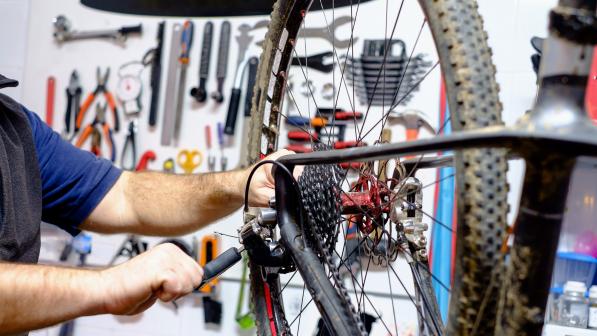Group test: Tubeless tyres

Reduced rolling resistance, improved comfort and fewer punctures: these are the benefits touted for tubeless road tyres. A measure of liquid sealant goes in the tyre instead of an innertube. It’s not a simple swap.
You need: tubeless tyres; wheels with tubeless rims (I used Novatec Thirty wheels, £149/pair); tubeless valves (around £10/pair); tubeless rim tape (£10); sealant (£15/pint); and a high-volume track pump or other fast inflator (I used an Airshot, £60).
Going tubeless isn’t cheap, and fitting can be messy. However, tubeless tyres can be run at lower pressures as they don’t pinch puncture. On imperfect roads, rolling resistance is thus lower due to reduced bump losses.
The lack of an innertube should reduce internal friction (hysteresis) and reduce rolling resistance further. Small holes are sealed automatically, with some loss of pressure. Carry a spare tube for larger holes.
1 Schwalbe Pro One
£56.99. Available from Schwalbe.

Schwalbe weren’t the first with tubeless road tyres but they’ve been pushing them hard, declaring them the future. A rosy future, certainly, judging by the Pro One.
This is a new improved version that’s lighter and evidently more cut resistant and quicker rolling than its predecessor. It does roll very well. It’s among the fastest tyres I’ve ridden and was second here only to the Specialized (by a difference that’s within my roll-down test’s margin for error).
It’s exceptionally comfortable for a road bike tyre. The 25mm nominal width stretched out to 27.3mm on the wide Novatec Thirty rims and can be inflated to a mere 70psi. At that pressure, it glides over any road roughness or irregularity like a really nice tubular.
Fitting and inflating it was a doddle compared to a traditional clincher let alone a tubular – and it won’t get binned after the first thorn, unlike a tube.
Sizes available: 23-622, 25-622 (tested), 28-622, 28-406.
Measured width: 27.3mm.
Weight: 260g.
Pressure range: 70-110psi.
Verdict: Comfortable and fast, the Pro One fully exploits the lower-pressure potential of tubeless.
2 Specialized Roubaix Road Tubeless
£80. Available from Specialized.

Specialized call this tyre 700×23/25C; the slash is because it’s a 23mm-width tread on a 25mm casing. It is about 25mm wide – less than I expected, because tubeless rims are wider to support the tyre better and stop it rolling off, plumping up tyre width as a side effect.
The Roubaix RT is comfortable enough but didn’t roll over rough tarmac or Scarborough’s Marine Drive pavé as smoothly as Schwalbe’s Pro One, which is only nominally the same width. It’s surprisingly fast-rolling, however.
This is an endurance tyre not a race tyre, and Specialized describes it as an all-rounder that’s also suitable for ‘rough field roads’. Yet according to my roll-down tests it was narrowly the fastest here, just pipping the Pro One. Getting it on the rim and inflated was effortless.
Sizes available: 23/25-622.
Measured width: 24.9mm.
Weight: 288g.
Pressure range: 90-115psi.
Verdict: A very quick and capable any road tyre. Sadly, in only one size.
3 Maxxis Padrone TR
£49.99. Available from Maxxis.

TR stands for tubeless ready, a description I’d dispute. I spent a lot of time, effort and tyre sealant trying and failing to get the Maxxis Padrones to pop into place on my tubeless rims.
The Airshot wouldn’t do it – a first. Nor would the usual tricks such as putting a tube in temporarily to get one bead in place or spraying soapy water on the beads. It would not take air.
I didn’t try building up the rim with tape as tubeless tyre tolerances should be better than this, given the consequences of failure.
I did try them with an innertube. They were very good, handling and rolling like a quality road tyre should. But putting a tube in defeats the purpose of a tubeless-ready tyre.
Sizes available: 23-622, 25-622 (tested), 28-622.
Measured width: 25.5mm.
Weight: 258g.
Pressure range: 105-125psi.
Verdict: Too loose on the rim to go up tubeless. Disappointing.
4 Panaracer Race A Evo 3 Tubeless
£59.99. Available from ZyroFisher.

These are the narrowest tyres here, nominally 23mm and measuring little more. It wasn’t that Panaracer didn’t get the memo – that 25 is the new 23 – rather that the 23mm option was all the distributor had available.
They weren’t quite as easy to get on the rim as advertised; I needed a tyre lever. But they went up well, held air well and rolled well.
There was little to differentiate these from the Specialized Roubaix or the Schwalbe Pro One in roll-down terms. In the past when I’ve tested Panaracer Race tyres, I’ve found the tacky tread picked up fine road grit.
That wasn’t a problem, despite the lower pressure. Grip was fine too, showing that rubber compound trumps tread pattern on tarmac.
Sizes available: 23-622 (tested), 25-622.
Measured width: 23.55mm.
Weight: 276g.
Pressure range: 90-120psi.
Verdict: User friendly and easy rolling, but 23mm only trumps 25mm for tight-clearance bikes.
First published in Cycle magazine, June/July 2016 issue. All information correct at time of publishing.
Cycle magazine
Every two months Cycling UK members receive Cycle magazine, filled with interesting and informative articles, news and reviews for all cyclists.
Members can read the magazine in full online; non-members can read selected highlights.







